Col. Sudhir Farm

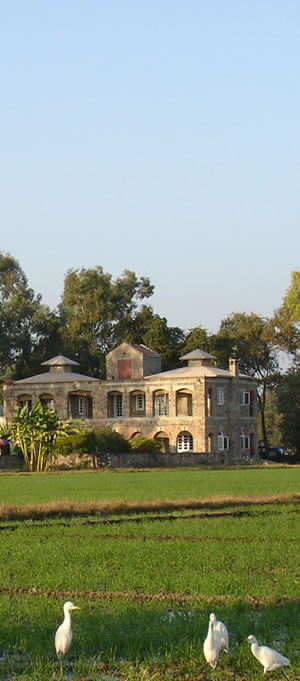


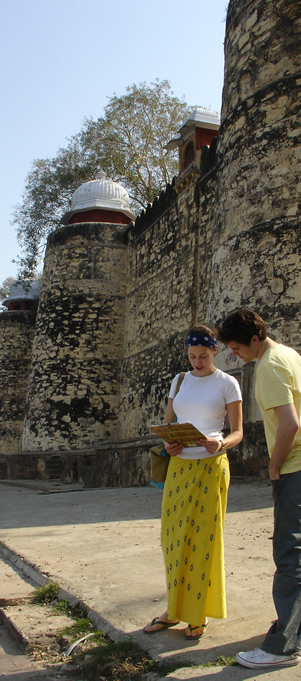

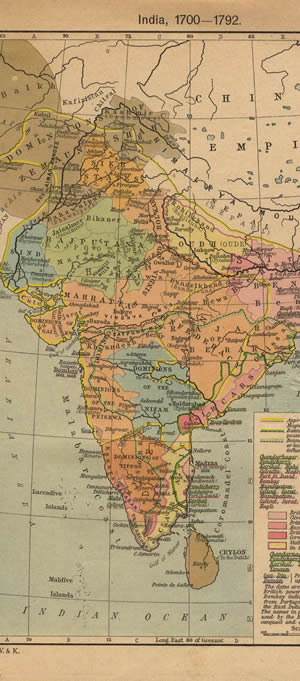
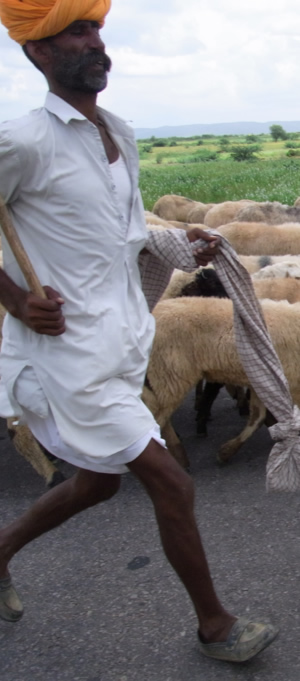
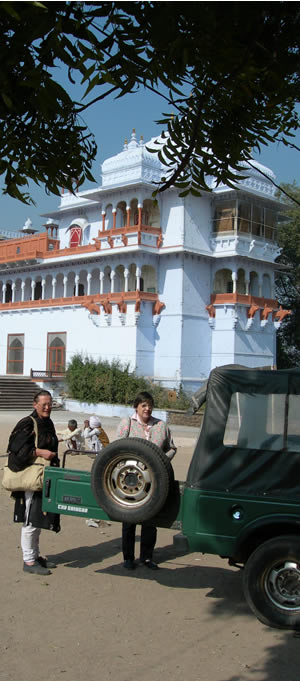
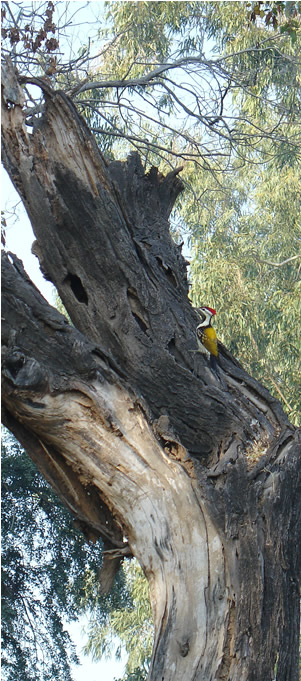
Snippets from the Visitors' Book
The Kota tonga trail was a real highlight - a bit like a 19th Century treasure hunt. It’s full of little nuggets of unusual information and fascinating glimpses into the unsolved mysteries of Kota.
Harriet and Will, London. UK
The memorial to Major Burton and his sons was much more moving than the Taj Mahal or the lake at Udaipur, marvellous as they are.
Henry Vane, Cumbria, UK
...the most comfortable bed I’ve slept in for 2 months....
Charlotte Adam, Winchester UK
Two days out of the noise and the people in a beautiful place. We felt totally
at home
- To be recommended to every person who wishes to experience the Indian country life. We also liked the way the food was prepared...
Patrick & Marie-Christine Lemaigre, Nil-St Vincent, Belgium
We’re only here for the porridge and home made bread! Thank you for a most wonderful time the memories of which we shall carry always. You have given us a wonderful & fascinating introduction to India.
Sue Turner, Lancashire, UK
So ...Rajasthan is not all desert! Thank you for sharing everything with us....
The Read family, London, UK
What a wonderful time we’ve had at the school in the village, at the weavers’, on the river, atop a tonga! Thank you for all your help and contacts throughout India
Anne Gerbner, Philadelphia, USA
It was a wonderful stay and thank you for giving us such a positive look at India and Rajasthan.
Salma Goldstein, New Jersey, USA
- There once was a lady of Kota
- Who took visitors out in her motor
- With the roads and the ruts
- It took quite some guts
- To go out with the lady of Kota.
- But once back at home on the farm
- The world quite descended to calm
- With the plants and the birds
- And fox terriers in herds
- There was balm in the calm on the farm.
Sue Millar, London, UK
After travelling around Rajasthan for two weeks, reaching a real house with books on the shelves, photos on the walls and four happy dogs was simply wonderful.
Camille Savinien, Paris, France
This isn’t tourism. I know of nowhere else where you can experience the real India as well as on your traditional working Rajasthani farm.
Sam Milward, Wellington, New Zealand
Thank you so very much for such a wonderful stay - what a fantastic introduction to India. I don’t think we’ll find such tranquillity elsewhere.
Lizzie Fortune, Hampshire. UK
Fabulous - I’ve been spoilt. It’s hard to leave and face the real world.
Elisabeth Simson, Isle of Wight, UK
After travelling around Rajasthan for two weeks, reaching a real house with books on the shelves, photos on the walls and four happy dogs was simply wonderful.
Camille Savinien, Paris, France
This isn’t tourism. I know of nowhere else where you can experience the real India as well as on your traditional working Rajasthani farm.
Sam Milward, Wellington, New Zealand
Thank you so very much for such a wonderful stay - what a fantastic introduction to India. I don’t think we’ll find such tranquillity elsewhere.
Lizzie Fortune, Hampshire. UK
Our visit at the farm was truly wonderful, off the beaten track it is a slice of India a visitor does not normally experience. Victoria is very knowledgeable about Indian culture and the people - an added perspective for us. The food here was very delicious: organically home grown ingredients, vegetables, fruits, grains prepared simply homestyle. A nice change from curries. Enjoyed the early morning boat ride and walk to the weavers. Many thanks.
Johanna Janssens, Washington, USA
I loved staying with you and the dogs and playing with the toys.
Jonas aged 8, Switzerland
A very welcome break from the crazy world of India – wonderful house, food and hospitality. Thank you so much.
Katie Buxton, Bath, UK
I loved seeing the crocodiles, and I learned a lot about deticking the puppies. Coming to the farm was a great experience.
Stella Bartholet, Washington, USA
A wonderful eye opening visit in every sense. We will be back! Thank you!
Christopher & Joanna Hobson, Northamptonshire, UK
A blissfully peaceful stay. We enjoyed everything – even the power cut. Thank you for lovely food, good company and very interesting trips.
Vicky Stark, London, UK
Exactly what we hoped for and more, bits of India off the tourist track, life as it actually is in villages, teeming life and livestock and the magic of the river.
Sir Hilary Miller, Worcester, UK
Thank you for the introduction to miniature painters, wall paintings, stories, great food, good company, walk through the fields. I loved the paintings in the City Palace and go back full of inspiration and memories.
Nan Mulder, Edinburgh, UK

On the Farm - 2012 Archive
On the Farm - December ’12
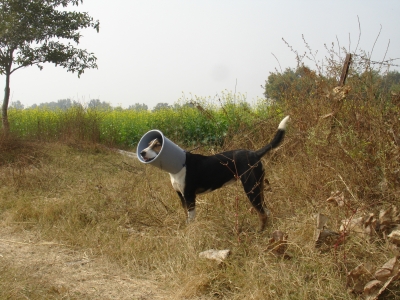 The enduring images of December are of Lucy and her collar against a background of fluorescent yellow flowering mustard. Lucy is 10 months old and was sterilised by the Kota Animal Welfare Trust on 4th December. Whereas street dogs heal in three days, Lucy has taken a month and has been wearing the blue dustbin hood for the last three weeks having previously removed her external stitches three times. We should have kept her collared with a hood and tied her the first week and all might have been well.
The enduring images of December are of Lucy and her collar against a background of fluorescent yellow flowering mustard. Lucy is 10 months old and was sterilised by the Kota Animal Welfare Trust on 4th December. Whereas street dogs heal in three days, Lucy has taken a month and has been wearing the blue dustbin hood for the last three weeks having previously removed her external stitches three times. We should have kept her collared with a hood and tied her the first week and all might have been well.
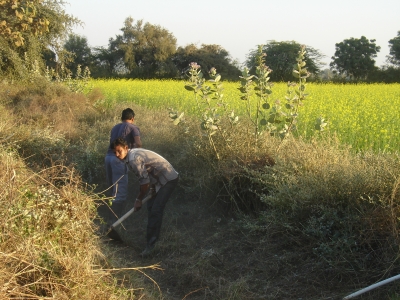 The main farming activities were pre-watering and sowing of wheat and watering the mustard just before it flowered. Here the men are clearing monsoon growth from a water channel so we can start watering from the canal which is brim full after a good monsoon. No rain since September though unlike other parts of the world....
The main farming activities were pre-watering and sowing of wheat and watering the mustard just before it flowered. Here the men are clearing monsoon growth from a water channel so we can start watering from the canal which is brim full after a good monsoon. No rain since September though unlike other parts of the world....
The rice sold for a good price which was 60 percent up on last year. Good for farmers but not rice eaters. A nightly battle was waged in December against stray cows forcing their way into the farm to eat the young wheat and the green fodder for our cattle called bersin. Vijay made regular rounds with the air-gun. One more young male seems to have adopted us. There is less loss in tying him up and feeding him then in risking him foraging freely every night. Again he is half-Jersey and shunned by deshi Indian cows which wander about in groups.
On the Farm - November ’12
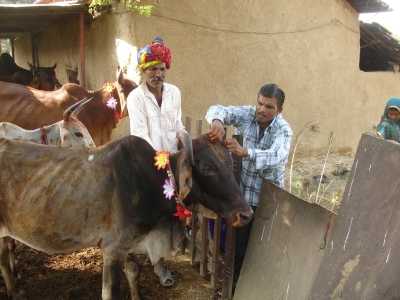 Divali is the highlight of November. On the day after, there is a ceremony to honour the cows. Here you can see their jaunty garlands. Mun-mun has seen 17 of these pujas previously and looks forward to the sweet puris (fried chapattis) they are fed.
Divali is the highlight of November. On the day after, there is a ceremony to honour the cows. Here you can see their jaunty garlands. Mun-mun has seen 17 of these pujas previously and looks forward to the sweet puris (fried chapattis) they are fed.
 On November 2nd a team of ten women started hand-cutting the rice and they worked every day for a month. They tied it in bundles and hit each bundle against a barrel. The grain that was knocked out was then fed into a thresher. No rain all month - so no damage to the dry crop.
On November 2nd a team of ten women started hand-cutting the rice and they worked every day for a month. They tied it in bundles and hit each bundle against a barrel. The grain that was knocked out was then fed into a thresher. No rain all month - so no damage to the dry crop.
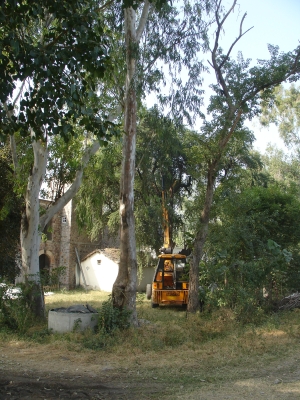 The farm suffered two major losses this month: one was the loss of our dog Misty, who disappeared on November 1st never to be seen again; and the second was this enormous and iconic wood-apple or kainth tree. The kainth has stood for decades and it is said that a tiger was shot under it 60 or more years ago before the jungle was cleared. It had become hollow and was a danger to the house. We hired a crane to support the weight of the top trunk while a local bhil axed it. Then a team of men cut up the wood and took it away the following day. The lower trunk and branches are still standing which is some comfort to the spotted owlets and woodpeckers that frequented the tree. There were five hornets nests in it which had been unreachable. We appear to have an unusual variety of happy hornets as despite living in a cloud of them for the past month, not a single person had been stung!
The farm suffered two major losses this month: one was the loss of our dog Misty, who disappeared on November 1st never to be seen again; and the second was this enormous and iconic wood-apple or kainth tree. The kainth has stood for decades and it is said that a tiger was shot under it 60 or more years ago before the jungle was cleared. It had become hollow and was a danger to the house. We hired a crane to support the weight of the top trunk while a local bhil axed it. Then a team of men cut up the wood and took it away the following day. The lower trunk and branches are still standing which is some comfort to the spotted owlets and woodpeckers that frequented the tree. There were five hornets nests in it which had been unreachable. We appear to have an unusual variety of happy hornets as despite living in a cloud of them for the past month, not a single person had been stung!
On the Farm - October ’12
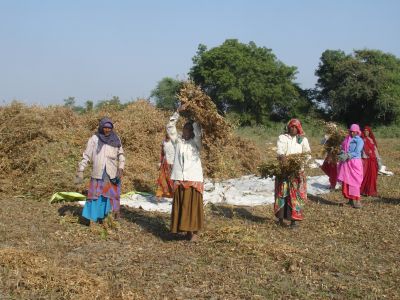 On October 10th the new transformer was finally installed and watering of the rice could start again. It has aluminium wire winding, rather than copper, and we hope the thieves will find it a less than attractive proposition. We called a welder to weld the frame that supports it so that it is now difficult to bring the whole frame down the two poles.
On October 10th the new transformer was finally installed and watering of the rice could start again. It has aluminium wire winding, rather than copper, and we hope the thieves will find it a less than attractive proposition. We called a welder to weld the frame that supports it so that it is now difficult to bring the whole frame down the two poles.
Both of our bitches, Lucy the newly grown-up puppy, and her mother Misty were on heat this month. They had to be tied up and walked separately and the uninvited admirers deterred with airgun pellets for over two weeks.
On the 19th a team of ten women started cutting the soyabean crop. After allowing it to dry in small piles it is brought together in a big heap for threshing as seen here.
 The land to be sown with mustard was all ploughed and watered before sowing. The threshing of the soyabean began on 29th. Some is still too damp to thresh.
The land to be sown with mustard was all ploughed and watered before sowing. The threshing of the soyabean began on 29th. Some is still too damp to thresh.
The vegetable patch was also ploughed twice. Here is little Dashrath helping to plant potatoes. Potatoes garlic, spinach, carrots, peas, methi, onions, mooli, beetroot and tomatoes have all been planted. It is now a battle to deal with the meadow grass that springs up without using chemicals.
On the Farm - September ’12
 Another month of heavy rain, yet watering problems. This is what a looted transformer looks like. The submersible pump burnt out on 4th September while running 24 hours (barring short power cuts) to water the rice. It couldn’t be hoisted out with our block and tackle as it had jammed inside the casing 50 feet below ground-level. Since it had been raining hard it didn’t matter immediately; but then only five nights later copper wire thieves looted our transformer, yet again, despite locks and precautions (see March 2011 for the previous theft). So now no pump and no transformer.
Another month of heavy rain, yet watering problems. This is what a looted transformer looks like. The submersible pump burnt out on 4th September while running 24 hours (barring short power cuts) to water the rice. It couldn’t be hoisted out with our block and tackle as it had jammed inside the casing 50 feet below ground-level. Since it had been raining hard it didn’t matter immediately; but then only five nights later copper wire thieves looted our transformer, yet again, despite locks and precautions (see March 2011 for the previous theft). So now no pump and no transformer.
The police showed little interest in catching the thieves and finally appeared on 21st September and wrote the report while standing on the road, 100 metres away from the crime scene. By the end of September a new transformer had not been sanctioned, but a private team of pump experts removed the jammed submersible pump. It was rewound and re-installed within two days. It is currently connected to our neighbour’s transformer and electric supply, as it is his share cropped rice that is at stake.
 Here is a picture of two mothers and their young. Mun-mun is 18 and this is her twelfth calf, Charlotte. Asha is 20 and her first child is four months. They co-exist very closely during the rains as her house is on a dry island surrounded by mud. A second calf was also born in September, and has been called ‘Kakko’ meaning uncle, by 5-year old Dashrath, after the cow man.
Here is a picture of two mothers and their young. Mun-mun is 18 and this is her twelfth calf, Charlotte. Asha is 20 and her first child is four months. They co-exist very closely during the rains as her house is on a dry island surrounded by mud. A second calf was also born in September, and has been called ‘Kakko’ meaning uncle, by 5-year old Dashrath, after the cow man.
 By the end of September the rains had finally stopped and here is Dashrath’s mother, Sita, redoing the leepna: it is a mixture of chaff, infertile soil and cow dung which is spread on the ground.
By the end of September the rains had finally stopped and here is Dashrath’s mother, Sita, redoing the leepna: it is a mixture of chaff, infertile soil and cow dung which is spread on the ground.
On the Farm - August ’12
Plenty of rain this month so abundant growth of crops and general greenery. Both the soyabean and rice were hand weeded at disproportionate expense. Twenty-eight soyabean weeders appeared one day. All the surrounding farmers sprayed herbicides and pesticides at a fraction of the cost. We have a tiny baby on our farm this year and five-year old Dashrath and don’t want to take risks. Three calves died mysteriously within twenty-four hours last year shortly after a nearby rice field was sprayed. Coincidence?
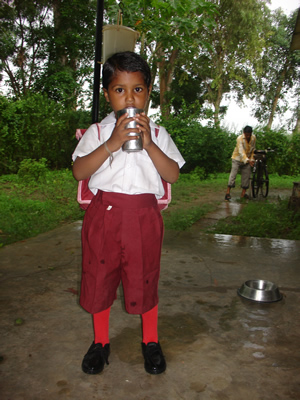 Dashrath started school in July. Here he is in his very smart private school uniform. He comes to the kitchen door at about 0715 hrs. every day for a glass of milk and then goes on his father’s bicycle for a 0730 hrs. start. He is collected at 1230 hrs. The economics are mysterious. There are ten children in Dashrath’s class and they pay Rs.80 a month each. That is 1 GBP. What is the teacher earning?
Dashrath started school in July. Here he is in his very smart private school uniform. He comes to the kitchen door at about 0715 hrs. every day for a glass of milk and then goes on his father’s bicycle for a 0730 hrs. start. He is collected at 1230 hrs. The economics are mysterious. There are ten children in Dashrath’s class and they pay Rs.80 a month each. That is 1 GBP. What is the teacher earning?
With mother working in the fields, Dashrath joins his father in the afternoon or herds the cows with his ‘uncle.’ Aged 5, he is usually to be seen with a sickle (a blunt one) or a stick.
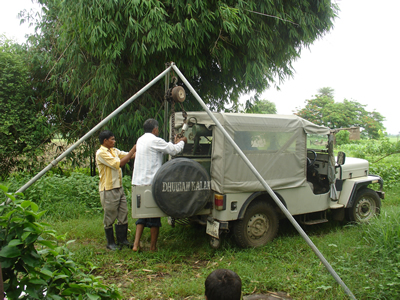 The electric pump was running to water the rice but stopped suddenly on August 7th. Now that the meter is integral to the transformer, you can no longer bypass the meter if it has a burnout, which it had. Along with the necessary application paperwork the transformer had to be lowered and delivered to the electricity supply company at our expense. It weighs 300 kg. The meter was replaced and the transformer sealed, spot welded at our cost and transported back. Here a block and tackle is being used to raise and extract the transformer from the jeep to be put onto a small trailer pulled by a tractor for the last 300 metre journey along a muddy track. The whole episode took 10 days.
The electric pump was running to water the rice but stopped suddenly on August 7th. Now that the meter is integral to the transformer, you can no longer bypass the meter if it has a burnout, which it had. Along with the necessary application paperwork the transformer had to be lowered and delivered to the electricity supply company at our expense. It weighs 300 kg. The meter was replaced and the transformer sealed, spot welded at our cost and transported back. Here a block and tackle is being used to raise and extract the transformer from the jeep to be put onto a small trailer pulled by a tractor for the last 300 metre journey along a muddy track. The whole episode took 10 days.
On the Farm - July ’12
July saw the beginnings of the monsoon and the planting of soyabean. A Bihari team of men came and transplanted the rice and then went back to Bihar. Local women will weed and harvest it.
Wooden fence posts and barbed-wire were put up along the burnt hedge boundary and seeds of Subabool (leucaena leucocephala) planted along the fence. Subabool is a native of Central America and is thornless and drought hardy. It has long seed-bearing pods enjoyed by the cows. It has already germinated well and we hope to lay it and create a thick hedge. There is no tradition of laying hedges in this part of India.
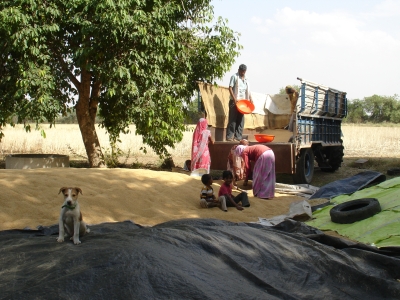 The most unusual July event was the disappearance of our five-month old puppy, Linux, on July 20th (here he is aged three months in the photograph, guarding the wheat). He was at the gate at 5 p.m. but has not been seen since. The Municipal Council dead animals removing team came at 7 p.m. to take away a two-year old cow that had died suddenly that afternoon. She had had a large external hernia caused by damage to the stomach wall when young. Did that kill her? Was she bitten by a snake? Did the men take Linux? Did somebody else? We may never know.
The most unusual July event was the disappearance of our five-month old puppy, Linux, on July 20th (here he is aged three months in the photograph, guarding the wheat). He was at the gate at 5 p.m. but has not been seen since. The Municipal Council dead animals removing team came at 7 p.m. to take away a two-year old cow that had died suddenly that afternoon. She had had a large external hernia caused by damage to the stomach wall when young. Did that kill her? Was she bitten by a snake? Did the men take Linux? Did somebody else? We may never know.
On the Farm - June ’12
 In Memoriam:
In Memoriam:
On June 2nd at 11:30 a.m, Gauri our oldest cow, was found dead. She had been on ‘her last legs’ for over two years and this photo can be found in the 2010 June archives.
Gauri had been sitting quietly all night but refused water and without a fuss faded away. She had always been a very gentle and sweet-natured cow but hers had been a singularly sad and lonely life and she is not survived by any of her progeny.
Adopting us in 2003, Gauri had probably been abandoned by drovers passing by with their large herds of Gujarati Gir cattle on their annual migration to the greener pastures further south. She had her first calf in 2006 and seven more subsequently. Only three were female and likely to be kept. One died of pneumonia, the second mysteriously within hours of birth, and the third - her final calf - died of a snake bite aged 17 months in 2010.
Since then, Gauri had lived a lone and serene existence. She was nineteen, and if anyone knows of an older cow, please let us know. We will remember her.
On the Farm - May ’12
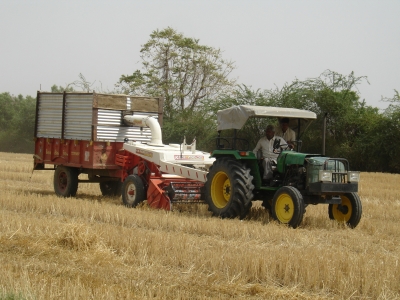 Hoping to avoid having to burn stubble we hired this machine, after the combine had harvested the wheat, to cut the stalks shorter and to chop them up into chaff or bhousa for cattle feed. Not a great success; the bhousa is too coarse and we had to burn the stubble anyway.
Hoping to avoid having to burn stubble we hired this machine, after the combine had harvested the wheat, to cut the stalks shorter and to chop them up into chaff or bhousa for cattle feed. Not a great success; the bhousa is too coarse and we had to burn the stubble anyway.
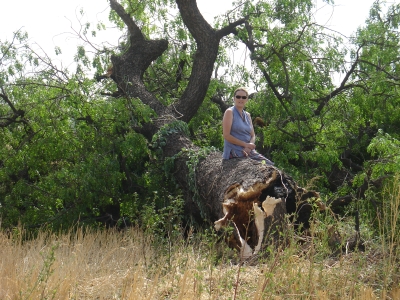 May witnessed some severe storms, and in one, this handsome neem tree which had graced the farm for decades blew over. As you can see, the lower trunk had been hollowed-out by fire during previous stubble burnings. We hired a crane to lift the main trunk and the heavy branches onto a trailer after everthing else had been sawn by hand.
May witnessed some severe storms, and in one, this handsome neem tree which had graced the farm for decades blew over. As you can see, the lower trunk had been hollowed-out by fire during previous stubble burnings. We hired a crane to lift the main trunk and the heavy branches onto a trailer after everthing else had been sawn by hand.

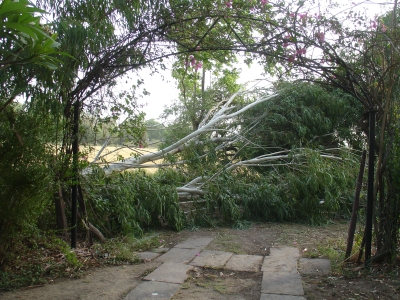
This eucalyptus snapped three metres above ground on a dry windless night blocking the drive and luckily not injuring anyone or any property. A chain pulley was used to take the weight while the trunk was being sawn.
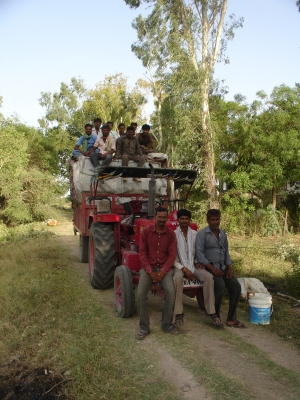 We engaged these men for two days to pollard leaning eucalyptus trees around the house. They paid Rs.4000 (about 50 GBP) for this full trolley of logs. With no chainsaws or safety equipment, they held on with one hand and hacked away using small axes with the other. All come from Umedganj, a village 1 mile away.
We engaged these men for two days to pollard leaning eucalyptus trees around the house. They paid Rs.4000 (about 50 GBP) for this full trolley of logs. With no chainsaws or safety equipment, they held on with one hand and hacked away using small axes with the other. All come from Umedganj, a village 1 mile away.
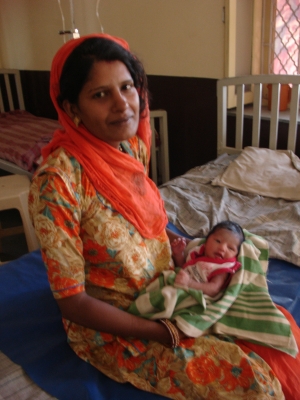 And lastly, new life among the destruction. Asha and Ranjeet’s first child, a boy. Ashish was born on May 25th at the R.C. Maternity Home, as seen here, in Kaithoon about 6 kilometres away. The air temperature was 40oC. Mother and baby were sent home within four hours of delivery. We were expected to provide all transport for free and to give medical advice at midnight. Before he was five days old, Ashish had had dehydration, fever, jaundice, blue-light therapy and anti-biotics. Happily, he is now thriving.
And lastly, new life among the destruction. Asha and Ranjeet’s first child, a boy. Ashish was born on May 25th at the R.C. Maternity Home, as seen here, in Kaithoon about 6 kilometres away. The air temperature was 40oC. Mother and baby were sent home within four hours of delivery. We were expected to provide all transport for free and to give medical advice at midnight. Before he was five days old, Ashish had had dehydration, fever, jaundice, blue-light therapy and anti-biotics. Happily, he is now thriving.
On the Farm - April ’12
April saw the great wheat scam and the great hedge fire of Dhakerkheri.
The State Government announced a high support price of Rs. 1285/100 kgs. of wheat with a further bonus of Rs.100/100 kg. but then closed the scheme early before the bulk of the wheat was harvested. The traders dropped their purchase prices in response and we had to sell as low as Rs. 1085/100 kg. which is less than two years back. The yield was good though this year because of an extended cooler period. In fact, it was the coolest April for twenty years and the temperatures did not reach 40oC. Two years ago it was 45oC daily.


These women are cutting the ‘experimental’ traditional variety of wheat C-306. The dark clouds heralded a heavy shower. The yield was three quintals per bigha as against eight of hybrid seed, so economically it does nto make sense to grow it, even though the inputs in terms of fertiliser and water are less. We are enjoying eating it ourselves though, but it is a high price to pay for a marginal difference in taste. The women have to sharpen their dentilees (sickles) up to five times a day when cutting wheat. Most of the wheat crop was combine harvested.
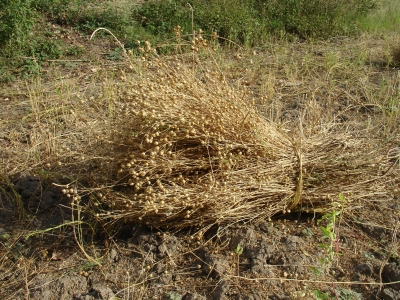 This is what linseed oil is made from. The little round pods shown here contain tiny dark brown linseed seeds that look like apple pips.
This is what linseed oil is made from. The little round pods shown here contain tiny dark brown linseed seeds that look like apple pips.
 Harvesting was over by the festival of Aakha Teej, April 25th this year, which is an auspicious day for rural weddings and many people walked past our farm to attend feasts. They walked back at midday and it is surely not a coincidence that fires broke out in two or three places along the boundary hedge running parallel to the road at that time. We called the fire brigade at 1245 hrs. and a single fire tender finally turned up at 1645 hrs. in time to douse the remaining burning tree trunks. It is claimed that the fire engines had been busy attending to a number of fires that day. By this time we had lost much of our hedge but had prevented the fire from spreading too far across the farm. The power was off, so we could only use buckets filled using the hand pump. Here you can see how the hedge has been burnt by the gate.
Harvesting was over by the festival of Aakha Teej, April 25th this year, which is an auspicious day for rural weddings and many people walked past our farm to attend feasts. They walked back at midday and it is surely not a coincidence that fires broke out in two or three places along the boundary hedge running parallel to the road at that time. We called the fire brigade at 1245 hrs. and a single fire tender finally turned up at 1645 hrs. in time to douse the remaining burning tree trunks. It is claimed that the fire engines had been busy attending to a number of fires that day. By this time we had lost much of our hedge but had prevented the fire from spreading too far across the farm. The power was off, so we could only use buckets filled using the hand pump. Here you can see how the hedge has been burnt by the gate.
 The 20-year old cow, Gauri, had settled in the shade in the fire's path and had to be pulled and pushed and goaded to get up and move out of danger. Another cow, Velvet, badly injured her shoulder joint and a local farmer from the neighbouring village was called. He heated curved iron rods in a cow dung fire and pressed them around the awkwardly sticking out joint. When eventually the joint was ‘loosened up’ she was allowed to get up and the joint appeared to move back into place. Kishan Gopal Meena said that he’d been taught this technique by bhagwan (God) and would take no payment for his services. His skills are well known for miles around.
The 20-year old cow, Gauri, had settled in the shade in the fire's path and had to be pulled and pushed and goaded to get up and move out of danger. Another cow, Velvet, badly injured her shoulder joint and a local farmer from the neighbouring village was called. He heated curved iron rods in a cow dung fire and pressed them around the awkwardly sticking out joint. When eventually the joint was ‘loosened up’ she was allowed to get up and the joint appeared to move back into place. Kishan Gopal Meena said that he’d been taught this technique by bhagwan (God) and would take no payment for his services. His skills are well known for miles around.
On the Farm - March ’12

 March was a month of puppies, Holi and mustard. Here Misty just can’t help laughing when she surveys her mixed brood.
March was a month of puppies, Holi and mustard. Here Misty just can’t help laughing when she surveys her mixed brood.
By the end of the month she was out flat from the effort of suckling her five puppies.
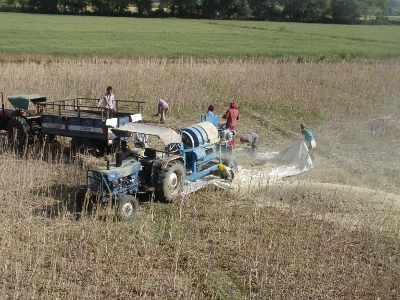 The mustard was hand cut and threshed by a team of women. Here they are just finishing after 17 hours spread over two days. You can see the tiny black mustard seeds in the trailer. This year the price of mustard increased by 49% over last year. This was partly because fewer people grew it this year as the price was low last year; partly because of poor germination in places reducing availability, and partly because of the good monsoon and the availability of canal water encouraging people to grow wheat. A litre of mustard oil now costs Rs.115 to extract, equivalent to GBP 1.40 at current exchange rates. Soon it may be cheaper to import food than to grow it in India where farming is labour intensive and land holdings small and fragmented - just a thought.
The mustard was hand cut and threshed by a team of women. Here they are just finishing after 17 hours spread over two days. You can see the tiny black mustard seeds in the trailer. This year the price of mustard increased by 49% over last year. This was partly because fewer people grew it this year as the price was low last year; partly because of poor germination in places reducing availability, and partly because of the good monsoon and the availability of canal water encouraging people to grow wheat. A litre of mustard oil now costs Rs.115 to extract, equivalent to GBP 1.40 at current exchange rates. Soon it may be cheaper to import food than to grow it in India where farming is labour intensive and land holdings small and fragmented - just a thought.
On the Farm - February ’12
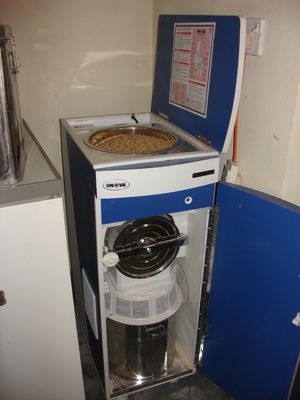 The yellow mustard flowers have fallen and seed pods have developed. The commercial wheat was watered for a second time using the canal water, but the traditional variety was not given a second watering as it is suited to dry conditions.
The yellow mustard flowers have fallen and seed pods have developed. The commercial wheat was watered for a second time using the canal water, but the traditional variety was not given a second watering as it is suited to dry conditions.
This month’s new toy is our personal flour mill. We used to take 15 kgs. at a time to the village electric mill (chakki) every ten days or so. Now our flour is never more than three days old, as we mill a bowl at a time. We can be sure of purity and the flour is finer although still 100% wholewheat.
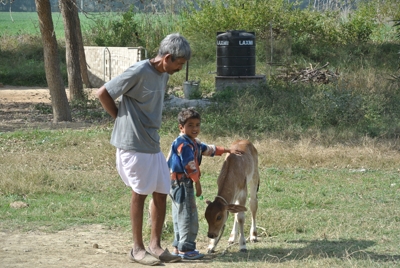 February has been a month of deaths and births. This new calf, Valentine, was born on 13th Feb. We have our own milk again after a gap of two months. Little boy Vikas has come to visit his grandfather Nagu.
February has been a month of deaths and births. This new calf, Valentine, was born on 13th Feb. We have our own milk again after a gap of two months. Little boy Vikas has come to visit his grandfather Nagu.
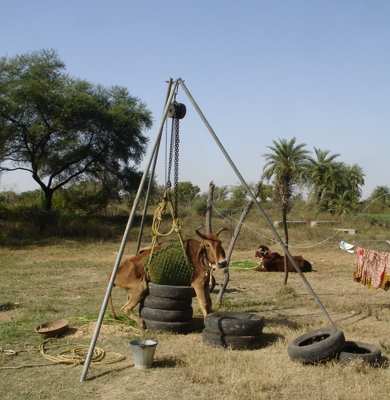
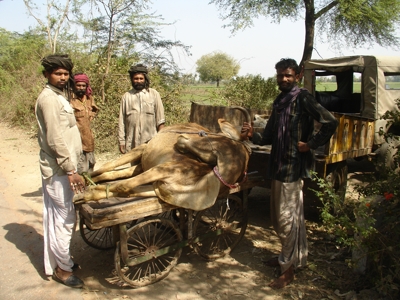
Lali, aged 16, was attacked and knocked over by Valentine’s mother Arti. She couldn’t get up. After two days we raised her in this contraption to let the blood circulate in her legs and we called the vet. She unexpectdly died in the night. Gauri, who is 19, and who has been on her last legs for three years, is in the background of this photo.
These are the men who work for the contractor with the authority to collect and dispose of dead animals. They are called Sathiyas, and considered so low in the social order that even sweepers will not eat with them. They live in small shelters, and it is rumoured that they cook and eat beef. As they do not send their children to school, there is little sign of them being integrated into mainstream society.
 By contrast, here is a man who has also not been to school but who is making a good earning for himself by private enterprise. He is an illiterate Muslim, but has a mobile phone on vibrate in his pocket and uses it for calculations competently. He bought Rs. 500 worth of scrap metal, bottles and newspapers from us and we bought six of his tea cups for Rs.30.
By contrast, here is a man who has also not been to school but who is making a good earning for himself by private enterprise. He is an illiterate Muslim, but has a mobile phone on vibrate in his pocket and uses it for calculations competently. He bought Rs. 500 worth of scrap metal, bottles and newspapers from us and we bought six of his tea cups for Rs.30.
 And lastly, here is Misty with her five pups - four male and one female - which were born on 23rd Feb. This picture was taken by a Canadian student, Gabriel Ellison-Scowcroft.
And lastly, here is Misty with her five pups - four male and one female - which were born on 23rd Feb. This picture was taken by a Canadian student, Gabriel Ellison-Scowcroft.
On the Farm - January ’12
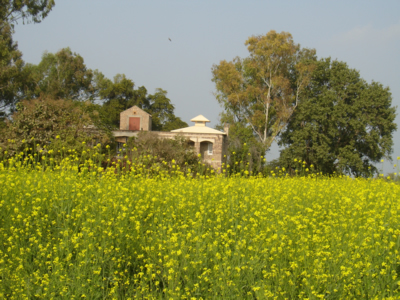
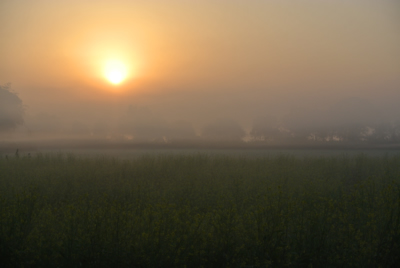
January is a spectacular month with misty sunrises and fluorescent yellow mustard fields surrounding the house.
 We had good rain on December 31st, which delayed the need to water our wheat by two weeks. We built a worm bed using bricks without mortar this time for our vermicompost for the vegetables. It is filled with layers of chaff and cow dung and watered daily. The experimental wheat can be seen in the background to the left of the mustard; one–half of this wheat sown with DAP chemical fertiliser mysteriously produced a good crop of mustard as well as the wheat. We can only assume that the DAP had been left over from the mustard sowing and contained the tiny black seeds. The mustard had to be hand weeded out.
We had good rain on December 31st, which delayed the need to water our wheat by two weeks. We built a worm bed using bricks without mortar this time for our vermicompost for the vegetables. It is filled with layers of chaff and cow dung and watered daily. The experimental wheat can be seen in the background to the left of the mustard; one–half of this wheat sown with DAP chemical fertiliser mysteriously produced a good crop of mustard as well as the wheat. We can only assume that the DAP had been left over from the mustard sowing and contained the tiny black seeds. The mustard had to be hand weeded out.
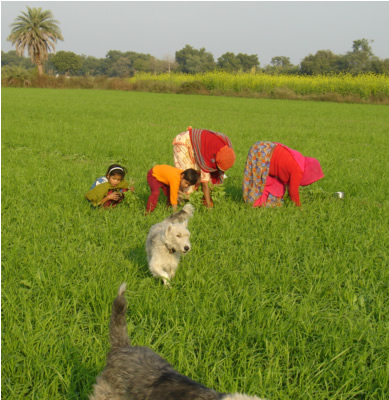 These children were given four days off school by the district Collector as he judged the unheated classrooms were too cold for the pupils. During their holidays they chose to join their relatives in the sunny fields, weeding out the mustard from the wheat field – no forced child labour this.
These children were given four days off school by the district Collector as he judged the unheated classrooms were too cold for the pupils. During their holidays they chose to join their relatives in the sunny fields, weeding out the mustard from the wheat field – no forced child labour this.
Tigger, our male dog, was attacked by two stray dogs this year and is confined to the house while his wounds heal. He wears a blue bucket contraption around his neck to stop him from licking the medicine from his wounds (also see January ’11 archive). Misty is expecting her first puppies on February 25th. They will be ¾ Fox Terrier and ¼ German Shepherd.
 An innovation by our electricity board to cut delivery costs is this hand held ‘spot billing machine.’ The meter reader taps in the reading and the bill emerges like an old–fashioned bus ticket, only longer. An estimated meter reading is issued if the meter reader cannot reach the meter in the fields because he did not bring his ladder, or if there is a power cut at the time which means the digital meter is out. Indeed there is the possibility of an understanding with the farmer to underestimate till after the harvest.
An innovation by our electricity board to cut delivery costs is this hand held ‘spot billing machine.’ The meter reader taps in the reading and the bill emerges like an old–fashioned bus ticket, only longer. An estimated meter reading is issued if the meter reader cannot reach the meter in the fields because he did not bring his ladder, or if there is a power cut at the time which means the digital meter is out. Indeed there is the possibility of an understanding with the farmer to underestimate till after the harvest.

